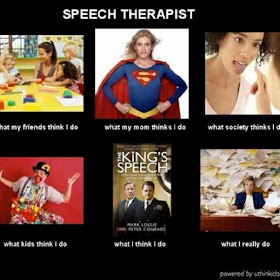As a student, the beginning of each school year comes with lots of exciting things. Shopping for a new outfit to wear on the first day of school, checking off the supplies on the classroom supply list, etc. Picking out folders was my favorite - what other children of the 90s out there can remember
Lisa Frank school supplies?! I secretly was excited at the end of each summer when the class lists were posted. Summer always seemed to last too long, and I was always excited for school to start again. I was a huge nerd.
As a school
employee, the beginning of each school year has a bit of a different feel. Yes, all the newness and excitement radiating from the students is a bit contagious, but mostly we long for summer break to start all over again. And as a school-based speech-language pathologist, the beginning of school means
scheduling. Bleh. I am somewhat fortunate this year as I only (only!) have 44 students and two buildings to worry about. I know some SLPs whose caseloads are pushing 70 students or have 3-4 buildings to schedule in the same 5-day school week.
Last year was my first year working in the school setting, and scheduling my 53 students at 2 different buildings was
such a big source of stress last year. I had at least two different excel spreadsheets, class lists, a list of how I was going to group the students together, and a 5-day calendar all on my desk at once. I think it took me a whole work week just to get the schedule to fit. It was a nightmare!
I was determined to complete my schedule differently this year. Somewhere over the summer I read the idea of using Post-It notes for scheduling, and I thought it was
genius! So here is how I completed my scheduling this year...
A couple weeks ago I gave each teacher a slip of paper that listed the students in their classroom who have speech services along with the minutes required each week for services, and asked them to attach a copy of their class schedule or list the times that will NOT work to pull students.
Click
here to download your own copy of these forms. I had more of my personal information on the slips I gave to teachers, but modified the document for general use for the purposes of this upload.
Once most of the teacher slips had been returned, I was ready to get scheduling! First, I organized my Post-Its by grade: preschoolers off campus got orange, preschoolers on campus got blue, Kindergarten got green, and 1st grade got pink. I wrote administrative/lunch/regular meetings on purple notes. Each student got a Post-It with their name/grade/teacher, how many minutes of therapy they were required each week, and the times the teacher had said were okay to pull the student. If a student was to be seen twice a week, they got two Post-Its with their name.
Then I made a giant 5-day schedule, divided into 20-minute increments (mostly for a guideline - it would be unrealistic to be able to fit my students perfectly into the designated time slots). A white board would work really well too, but
I don't have one in my room.
From there, I went to town sticking Post-Its into time slots that worked based on the times teachers had given me. I didn't need to keep referring to an excel spreadsheet to see teacher times or look back at old emails - everything I needed was right on the Post It. If a time didn't work, or if I needed to move a student to a different time, I could just pull off the Post It and move it to a different spot.
Scheduling was still a bit tedious since these students are all new to me, but it only took me
one day to finalize my schedule this year. Woohoo! Of course, I just know it's not actually final, and that conflicts and additions are bound to arise. But I think this was a pretty great system to use this year and I will more than likely tackle the project the same way in the future.
Leave a Comment: What tips do you have for making scheduling easier?














































.JPG)



